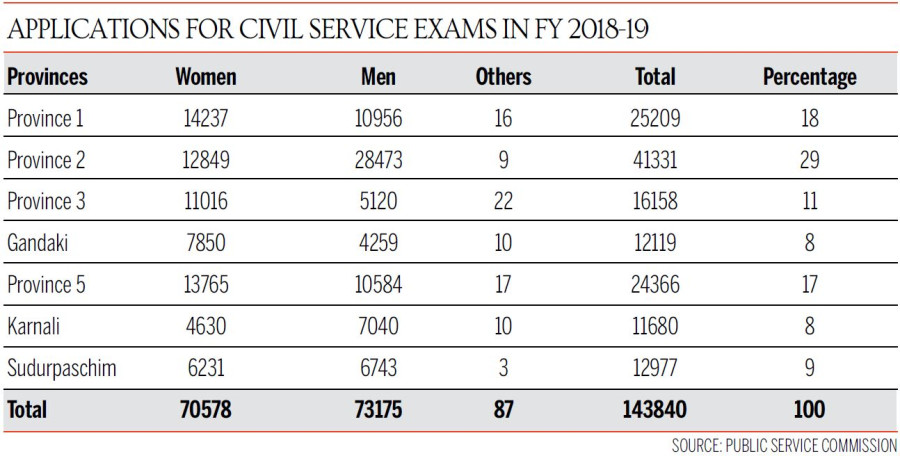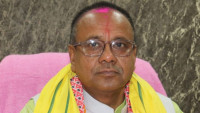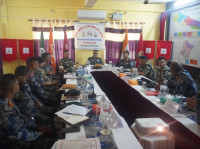Madhesh Province
Province 2 tops in government job applications, but response from women remains poor
Officials and experts say higher illiteracy among women is responsible for poor applications.
Prithvi Man Shrestha
Province 2 has topped the chart when it comes to applicants for civil service jobs under the vacancy notice called by the Public Service Commission. However, when it comes to women applicants from Province 2, their share in terms of percentage points compared to men is the lowest in terms of total applications received from women compared to other provinces, according to a new report of the commission.
According to the commission’s Annual Report for 2018-19, it received 143,840 applications from across the country and of them 41,331 were from Province 2.
Data showed the share of the applications from Province 2 alone stood at 29 percent of the total, leaving Province 1 a distant second with 18 percent. However, women applicants from Province 2 stood at 31 percent of the total applications.
Although the number of women applicants from Karnali Province and Sudurpashchim Province is also lower compared to men, the male-female gap is not as wide as it is in Province 2.
Women applicants outnumbered men in other four provinces—Province 1, Province 3, Gandaki and Provinc3 5. In the case of Province 3, the number of women applicants was more than double that of men.
An exactly similar situation prevailed in the fiscal year 2017-18 too when Province 2 topped the chart in terms of applications, accounting for 25 percent of the total applications.
When it came to women’s participation, only 33.6 percent of applications in the province were from women. The application trend from other provinces in the fiscal year 2017-18 too shows women outnumbering men in Provinces 1 and 3, Gandaki and Province 5.
“Province 2 tops in terms of applications and recruitment in the government service but women’s participation from there is disappointing compared to other provinces,” said Anandaraj Dhakal, secretary at the commission. “It is possibly due to low literacy rate of women in this province compared to other provinces.”
The average national literacy rate for women stands at 57.4 percent, according to Population Census 2011. But the Fact-Sheet published by UNWomen, a United Nations body that works for the rights of women, literacy rate in all eight districts of Province 2 is less than 50 percent. For example, illiteracy in Mahottari, Sarlahi and Rauthat is more than 60 percent.
For officials and experts, besides illiteracy, the long tradition of preventing women from outside exposure is another reason behind poor participation of women in government jobs.
“The women in Province 2, particularly the Madhesi women, are largely illiterate and it’s reflected in their interest to participate in the government jobs,” said Manchala Jha, a woman activist and former member of the Truth and Reconciliation Commission.
“If you don’t have enough qualified women to participate in exams to be conducted by the Public Service Commission, how can we expect their better participation?” said Jha.
Since Civil Service Act 2007 made the provision of reservation for various marginalised groups including women, the participation of women in civil service is on the rise. As per the law, 55 percent of the total seats have to be filled through open competition while the remainder are reserved for various marginalised groups in section officer positions.
Of the remaining 45 percent of the reserved seats, the quota includes 33 percent for women, 27 percent for indigenous nationalities, 22 percent for Madhesis, 9 percent for Dalits, 5 percent for the disabled, and 4 percent for backward regions. This greatly contributes to increasing women’s representation in the civil service, according to officials and experts.
The presence of women civil servants was 11 percent in the fiscal year 2007-08, which increased to around 25 percent in the fiscal year 2018-19, according to the Department of Civil Personnel Records.
But, when it comes to entry of women from Province 2 in the civil service, their number has remained poor. For example, last year, the commission recommended 940 candidates from Province 2 for civil service jobs, but only 181 were women, representing 20 percent of total recommended candidates from the province. The average ratio of women’s entry into civil service in the last fiscal year 2018-19 stood at 31.65 percent, according to the commission.
“Compared to other provinces, women in Madhesi community have lower exposure to education and the outside world, which limits their ability to participate and pass the exam,” said Anil Thakur, secretary at the Prime Minister’s Office, who belongs to Madhesi community. The Madhesi community has a dominant presence in the province.
“There is also a language barrier for them as well as they cannot communicate properly in both Nepali and English compared to men who are better exposed to both languages,” said Thakur.
Officials and experts, however, said that the changes are coming even though it may be slow. “People in Madhes are understanding the importance of education for girls. Particularly, women from the higher castes in Tarai are more educated and they are increasingly coming out of their household chores and fighting for the government jobs,” said Jha.
Underscoring the need for women empowerment in Tarai, Province 2 government has run “Beti Bachau, Beti Padhau” or “Save Girls, Educate Girls” campaign since January this year.
Under the scheme, every newborn girl child will be insured in all of the Province’s eight districts. The girls will receive their insurance amount as a lump sum after they get their citizenship certificates. Each of the insured girls will receive Rs125,000 for education. Jha said that the campaign is also aimed at educating women in order to empower them.




 7.12°C Kathmandu
7.12°C Kathmandu












